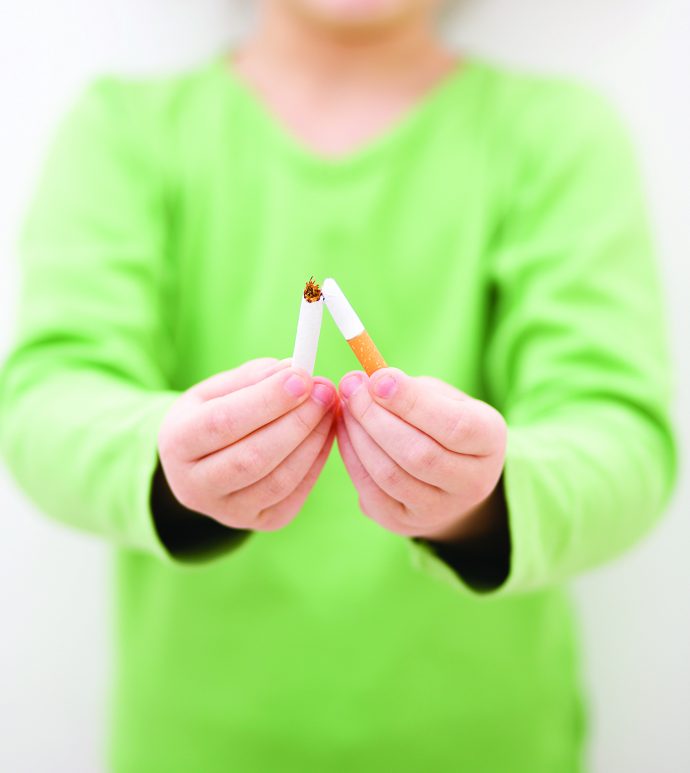The National Health and Morbidity Survey (NHMS 2017) cited that 1 in 10 students smoke. Have you ever wondered why smoking is so attractive to young people? As a parent, it might interest you to know that a majority of adult smokers began smoking before they turned 18, and many were addicted even before they finished secondary school!
Smoking is a form of harm that has been around for a long while (dating back to maybe even the first century BC!), affecting countless generations of people.
“Smoking is a huge burden, with 8 million deaths annually around the world due to complications resulting from smoking habits. There are about 1.2 billion smokers globally,” says Prof Dr Mohamad Haniki Nik Mohamed, President of the Malaysian Association of Adolescent Health. “In Malaysia alone, there are 20,000 premature deaths every year due to smoking, and close to RM3 billion is spent on treating three major diseases – ischemic heart disease (IHD), lung cancer and chronic obstructive pulmonary disease (COPD) – all of which are a result from complications of smoking!”
Smokers in Malaysia
A majority of smokers in Malaysia are male, and among the lower socio-economic B40 bracket, according to Dr Haniki, who is also the leader of Sustainable Smoke-Free Campus Community Flagship at International Islamic University Malaysia. He says that smoking not only affects the nation’s health, but also impacts the economy.
Today, adolescent smoking remains a major challenge for public health in Malaysia. Close to 5 million smokers in Malaysia are aged 15 and above. According to data that has been amassed over the years, smoking experimentation in Malaysia starts when a child is as young as 7 years old. In 2020, it was reported in the KOTAK (Kesihatan Oral Tanpa Asap Rokok) programme, an early smoking detection and intervention programme designed for all primary and secondary school children, that there were 12,152 smokers in secondary schools.
Dr Haniki shares that during adolescence, youths’ attitudes towards smoking are being formed, and they are especially vulnerable because experimentation is common during this time.
There are other factors that also affect an adolescent’s susceptibility towards smoking including their sex, genetic predisposition and psychiatric disorder, says Dr Haniki. “It doesn’t help that there are environmental influences as well – we see indirect advertisements everywhere, especially using cigarette packs.”
Then there’s nicotine. Nicotine is a stimulant drug that speeds up the messages travelling between the brain and body, and is the main psychoactive ingredient in tobacco products.
“Nicotine is the chemical in tobacco that makes it hard to quit,” explains Dr Haniki, saying that it produces pleasing, but temporary, effects in one’s brain. “These include pleasure, arousal, mood modulation and reduction in anxiety, among others. Studies have shown that it only takes three sticks of cigarettes to occupy all the receptors in one’s brain which explains why there is such a high affinity for smoking among youths.”
In contrast, when they don’t get their nicotine fix, they start to experience withdrawal effects such as irritability, insomnia, anxiety, increased appetite, restlessness and depression.
Passionate about tobacco dependence management, Dr Haniki reveals that in recent times, emerging tobacco products such as e-cigarettes have created a new problem, as much of this burden is set to land on the shoulders of adolescents and children in our society.
“There are 200,000 adolescents already smoking e-cigarettes today,” he shares the distressing data, adding that a growing number of girls are beginning to vape, which is a new turn of events given that in the past the percentage of women smokers in Malaysia has been low.
According to the National e-Cigarette Survey (NECS 2016), there are 450,000 dual users, who smoke both e-cigarettes and tobacco.
“Rather than being a method to stop smoking, e-cigarettes are more like a gateway to tobacco smoking and substance abuse,” shares Dr Haniki. “Adolescents use e-cigarettes for experimentation. They say they enjoy the taste and smell of e-cigarettes, and they want to try it out because it is trendy and a popular thing to do.
“There are those who claim that e-cigarettes are, in fact, effective if you decide to stop smoking but we don’t have enough high quality data to say this is true. And even though e-cigarette aerosols contain fewer toxic chemicals than conventional cigarette smoke, the bottom line is that all tobacco products, including e-cigarettes, carry risks. In fact, recent studies have shown that there are over 2,000 chemicals in e-cigarettes compared to what was publicised before,” he says, emphasising his strong belief that nicotine should not be legalised for leisure purposes.

Behavioural interventions
Prof Dr Wee Lei Hum is a Health Behavioural Expert specialising in Smoking Cessation and Workplace Health Promotion at the National University of Malaysia (UKM), and admits that her “pet subject” is helping smokers to quit smoking!
The first question she has for any parent is this: Are you a smoker?
If you are, Prof Wee offers a bunch of staggering truths for you:
- Adolescents with one parent as a smoker is 3x more likely to grow up into a smoker
- Having both parents smoking, doubles that risk
- Mothers are more likely to influence their daughters to smoke, and dads their sons
- An older sibling is 15x more likely to smoke in heavy smoking households (where parents/grandparents/uncles smoke) rather than non-smoking households
- A younger sibling is 6x more likely to smoke if an older sibling smokes
“All parents must understand that if they are smokers, they are effectively increasing the risk of their teenagers growing up to be smokers too,” Dr Wee emphasises. “As a parent, the best decision you can make is to go to a quit-smoking clinic as soon as you can so that your children don’t end up becoming smokers.”
Dr Wee stresses that for the child or youth, smoking is often perceived as ‘temporary’. She says: “They will say that they can ‘stop anytime’. They will never admit to being a smoker, and that is a dangerous mindset. Most adolescents don’t smoke every day. Even parents are often misled into thinking that this is just a phase and will say ‘Mereka suka cuba-cuba sahaja’.”
But the truth is that’s not the case. Dr Wee shares that most of her clients who have wanted to quit smoking started to smoke in their teenage years, and by the time they want to quit, they have a long history (30-40 years) of smoking.
“They come forward because they have health symptoms related to smoking. But by that time it’s hard to stop because they are already well and truly addicted to nicotine. Rates of failure and relapse are very high at this time. Many have a lot of regrets that they were ignorant of the fact that smoking is so addictive,” she reveals.
“Even monthly smoking can lead to dependence, and among young people there is very low motivation to stop. 70% try to quit every year, but 90% of those who try to quit, relapse.”
Dr Wee also shares that e-cigarette use has increased threefold among young people which is very worrying.
But all is not lost. Dr Wee suggests that parents use strategies such as STAR (Set, Tell, Anticipate, Remove) to motivate their smoking teens to quit.

Creating the right environment at home is also vital. She says: “Parents should create a home that is smoke-free and be a good role model for their children. Don’t allow friends and family to smoke inside your home. Refrain from smoking yourself. Raising children in a smoke-free environment also lowers the risk of developing asthma, pneumonia, bronchitis and ear infections.”
Other factors that parents should pay close attention to are the effects of social media, and your child’s peers at school.
“Children are getting very one-sided information from social media. Parents need to monitor where their children are getting their information from. They need reliable sources of information. For example, a child may think that the nicotine content in vape is lower, or that the fruit or vegetable content in vape is healthy, that it contains no tar or other hazardous chemicals, or that there are no health-related side effects when you vape.
“They may even feel that vaping is a way to stop smoking, and are not mindful of the nicotine content that is present in e-cigarette liquid,” Dr Wee says.
It takes a concerted effort from parents to ensure that their children are not tempted to ever pick up a cigarette or e-cigarette. And with advertising and social media, the challenge has grown by leaps and bounds.
Nonetheless, there is something all parents can do right now. Dr Haniki and Prof Wee encourage parents to stop smoking and keep their homes smoke-free so we can help build a smoke-free nation and achieve our government’s Tobacco Endgame 2040.
To sign up for a quit-smoking programme, go to jomquit.com








Comments